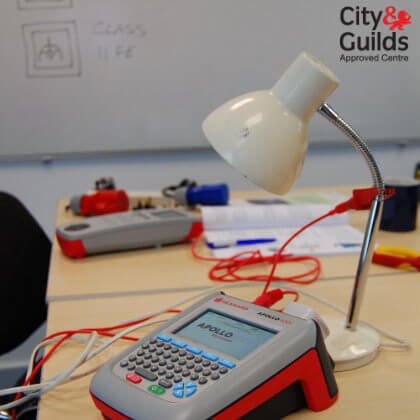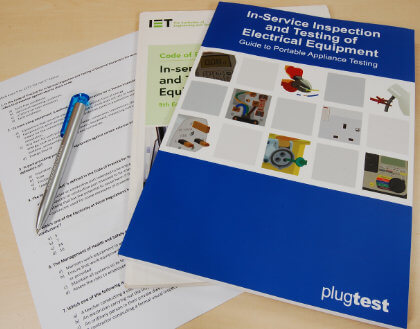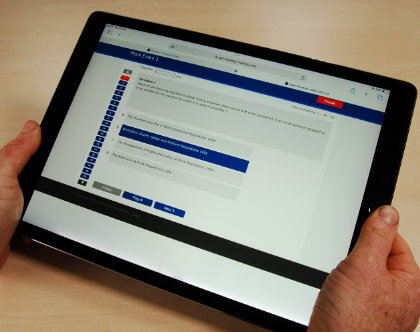
| Date | Venue | Price | Places |
|---|---|---|---|
| 27 - 28 March | Huntingdon, Cambridgeshire | £420.00 | |
| 24 - 25 April | Huntingdon, Cambridgeshire | £420.00 |
Course Outline
This City and Guilds PAT testing course is designed for those looking to gain the City and Guilds 2377 PAT testing qualification. The course is run over two days and combines both theory and practical elements to cover the syllabus. Assessment comprises a practical assignment module and a multiple choice online exam. Upon successful completion, candidates will gain the City & Guilds 2377-77 Level 3 Qualification.
Who is this Course For?
This course is ideal for those looking to offer PAT testing as a service, launch a PAT testing business, or embark on a career in PAT testing or the broader electrical sector. While the City and Guilds qualification isn't a legal requirement, it's well-recognised within the industry and is often a prerequisite for joining a professional membership association.
Entry Requirements
City & Guilds does not set entry requirements for this qualification. However, candidates attempting this qualification should have a good understanding of basic electrical principles. This foundational knowledge will aid in grasping the course content and ensure a more effective learning experience. Additionally, this qualification is only available to individuals aged 18 and over.
What's Covered in the Course?
The City & Guilds PAT testing qualification is structured around the IET Code of Practice for In-Service Inspection and Testing of Electrical Equipment 5th edition, published by the Institution of Engineering and Technology, and covers the following key areas:
| Section | What's Covered |
|---|---|
| Definitions and Standards | This section looks at the definitions used within the IET Code of Practice for In-Service Inspection and Testing of Electrical Equipment. Participants will be equipped with the knowledge to identify and understand the terminologies and descriptions given in the Code of Practice. |
| Statutory and Non-Statutory Requirements | Here, learners will be introduced to the statutory obligations and non-statutory standards and guidance related to the maintenance of electrical equipment. This includes understanding the scope of various documents, the guidance provided by the Health and Safety Executive, and the legal requirements to maintain electrical equipment safely. |
| Electrical Units of Measurement | This section provides an understanding of the electrical units of measurement associated with PAT testing. It covers important concepts such as voltage, current, resistance, and power, explaining their relevance in the context of electrical safety testing. Participants will also learn how to work with different units of measurement and perform necessary conversions. |
| Equipment Construction Classes and Protection | Diving deeper into the details of equipment construction, participants will learn about the different equipment construction classes, such as Class I and Class II, and their significance in ensuring safety against electric shocks. They'll also explore the various methods of protection integrated into electrical installations. By understanding these classes and protection methods, participants will be better equipped to select the correct tests and establish appropriate parameters for each type during testing, ensuring the safety and functionality of the equipment. |
| Procedures for In-Service Inspection and Testing | This segment emphasises the comprehensive procedures required for the in-service inspection and testing of electrical equipment. From the initial visual inspection to the final electrical tests, participants will be taken through a step-by-step process, ensuring they cover all necessary aspects. They'll learn about the importance of visual inspections, spotting damage, faults, and environmental factors that might affect equipment safety. Additionally, the section will cover the practical aspects of conducting electrical tests on different types of equipment and interpreting the results correctly, ensuring a thorough understanding of the entire inspection and testing process. |
| Management Requirements, Assessment of Inspection and Testing Frequency, and Record Keeping | This section focuses on the management responsibilities involved in overseeing the inspection and testing process. It highlights the need for effective systems to manage and document ongoing compliance. Participants will learn how to determine the appropriate frequency for inspection and testing, taking into consideration factors such as equipment type, environment, and associated risks. It also covers the requirements for accurate record-keeping, maintaining thorough documentation of all inspections and tests, and the requirements for labelling equipment to ensure clear communication of its status. |
By the end of this course, participants will be well-equipped with both theoretical knowledge and practical skills, ensuring they are competent in the in-service inspection and testing of electrical equipment.
Course Assessment
The C&G 2377-77 qualification assessment is comprised of two distinct elements:
- Practical Assessment (Unit 702): This assignment involves a hands-on evaluation where each student is assessed on their ability to inspect and test two pieces of equipment and complete the necessary documentation. While we provide all the required test equipment for this assessment, candidates are welcome to use their own instruments if they are more comfortable with them.
- Multiple-Choice Exam (Unit 701): This is a 1 hour 45-minute exam consisting of 50 multiple-choice questions. Candidates are allowed to refer to the IET Code of Practice during this open-book exam. The exam is designed to test the knowledge and understanding of the course material, and a pass mark of 80% is required.
Training Materials

We provide a training manual tailored specifically to the course content. For those keen to prepare in for the C&G course in advance, an online version of this manual is accessible through your course account, allowing for at-home study. The IET Code of Practice for In-Service Inspection and Testing of Electrical Equipment, 5th edition, is not just a reference but is also necessary for the exam. Some questions will require candidates to consult tables and data within the Code of Practice. Therefore, having this document is crucial, and we strongly advise purchasing it ahead of the course to familiarise yourself with its contents.
Exam Preparation

During the course, we ensure you're well-prepared for the City & Guilds exam by conducting mock exam sessions. These practice sessions are designed to build your confidence and familiarity with the exam process. Once you've enrolled, you'll have access to additional mock exams in your course account for extra practice at home. Plus, for those considering the course or curious about the exam, we provide a free, shortened version of a mock exam on our website. This sample exam offers a preview of the types of questions you'll encounter, aiding you in your decision to join our PAT training program.
Learning Outcome
By the end of the City and Guilds PAT Testing course, participants will:
- Demonstrate Proficiency in applying the IET Code of Practice for In-Service Inspection and Testing of Electrical Equipment in real-world scenarios.
- Conduct Comprehensive Inspections by identifying potential damage, faults, and environmental factors that could compromise equipment safety.
- Accurately Classify and Test electrical equipment based on its construction class and ensure the correct testing parameters and methods are applied.
- Interpret and Report on the results of electrical tests, providing clear and actionable feedback for equipment maintenance and safety.
- Engage in Effective Decision Making by using the knowledge gained to determine the appropriate inspection and testing procedures for various equipment types.
Course Venue
The course takes place at our training centre situated on a peaceful organic farm just outside of Huntingdon, just a few minutes from the A1M. Away from the hustle and bustle of city centres, our venue offers a stress-free learning environment with free, easy parking, eliminating worries of traffic jams and parking hassles. It's easily accessible from Peterborough, Cambridge, and surrounding areas.
Plugtest Ltd
Red House Farm
Woodwalton
Huntingdon
Cambridgeshire PE28 5YL
01487 773777
9am - 5pm Mon - Fri
sales@plugtest.co.ukCustomer Reviews
Excellent course. While using a PAT tester may be fairly straight forward, understanding why the tests are needed and how to interpret the results are essential. Robert made you feel relaxed from the start and always had time to answer any questions that one had, without making you feel stupid. I must say that having done a few of the mock C&G exams before hand I was able to relax a lot more in the exam and hence read the questions properly without panicking.
Andy, Glosjob Handyman
Great course, well organised. I found it more difficult and extensive than expected but, the way that the mock exams were pitched I was ready for the exam and passed with high marks! Robert our tutor was knowledgeable and a good teacher, with a sense of humour, which always helps. Good course, great value for money.
Chris, CM Building Management Ltd
Fantastic course, the content and level was just right for all, providing more than enough training to be considered a competent person and to sit the City and Guilds assessment and exam. The trainer (Rob) was approachable and willing to share anecdotes and practical examples within the scope of the training syllabus. Great venue with easy parking and venue facilities. A relaxed and friendly training environment. I would recommend you to anyone wanting this course and qualification.
David, Barnsley
The pre-course information helped me gain some background knowledge prior to the course. Having known nothing on the course 24 hours before it started I was taught well, understood the content and passed the exam. Sign of a successful course and trainer if you ask me!
Rachel, Timico Ltd
Read More Reviews ❯
Frequently Asked Questions
Do I Need My Own PAT Tester for the Course?
We supply all the necessary test equipment for the duration of the course. If you have your own PAT tester, we encourage you to bring it along, and our trainers will be happy to offer guidance on its use. For those without any test equipment, it's advisable to complete the course before making a purchase. This ensures you'll have a clearer understanding of the equipment best suited to your needs after the training.
How can I prepare for the course in advance?
To get a head start on your training, once you book a C&G course with us, you'll have access to an electronic copy of our training manual and online mock exams through your course account. This allows you to study at your own pace before attending. The mock exams are a valuable tool to help you familiarise yourself with the exam's format and typical questions. A paper copy of the manual will be provided during the course, and we strongly recommend purchasing the IET Code of Practice as it's an essential resource for both the course and the examination.
Is there an online course option for the City and Guilds 2377 PAT testing qualification?
Online courses offer flexibility, but the City & Guilds portable appliance testing qualification requires in-person assessments, including a hands-on practical evaluation and a supervised examination. Therefore, it is not possible to obtain this qualification purely through online study. Our course is designed to provide the essential practical experience and in-person examination required to meet the City & Guilds criteria for certification.
How soon will I receive my results and certificate?
Typically, your exam results will be available within 30 minutes after the completion of the exam, so you won't have to wait long to find out how you did. As for the official certificate, it usually takes about 4 to 6 weeks to arrive. We process and send them out as quickly as possible once they are issued by City & Guilds.
What are my options if I don't pass the City and Guilds exam?
Should you need to retake the exam, we offer a resit at a fee of £98 +VAT. Resits are typically scheduled to align with our upcoming courses, subject to availability. If these dates don't suit you, we can also arrange a resit at our office in Cambridgeshire at a time that is convenient for you.
Are there any additional costs I should be aware of?
The course fee you pay includes the examination enrolment fee, so there are no hidden charges to worry about. However, purchasing the IET Code of Practice is recommended for your studies and the open-book exam. Any potential resit fees are not included in the initial course fee.
Does the qualification expire?
The City & Guilds 2377 qualification does not have an official expiration date. However, it's important to stay updated with any changes in legislation or industry standards. Regularly refreshing your knowledge and skills is recommended, especially if there are any updates to the IET Code of Practice.
What career opportunities can this qualification lead to?
The City & Guilds 2377 qualification is widely recognised in the industry and can lead to opportunities in PAT testing services, electrical maintenance roles, and health and safety positions within various sectors.
Can I get a refund if I cancel my booking?
If you need to cancel your booking, we offer a full refund provided you give us notice at least two weeks before the course date. Please refer to our booking terms and conditions for detailed information on cancellations and refunds.
Read More FAQs ❯
Contact Us
If you require further information or have any queries, please feel free to get in touch.
